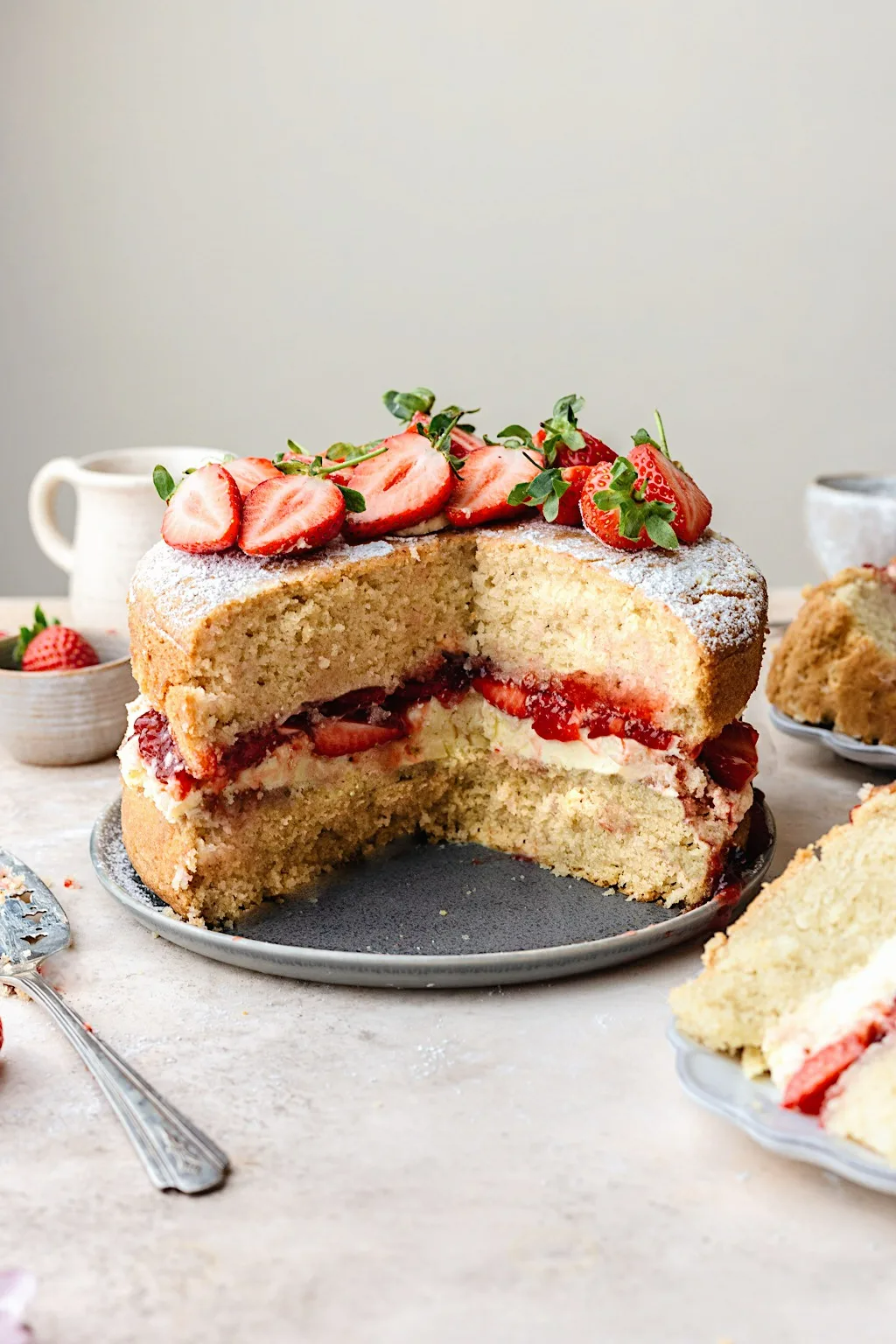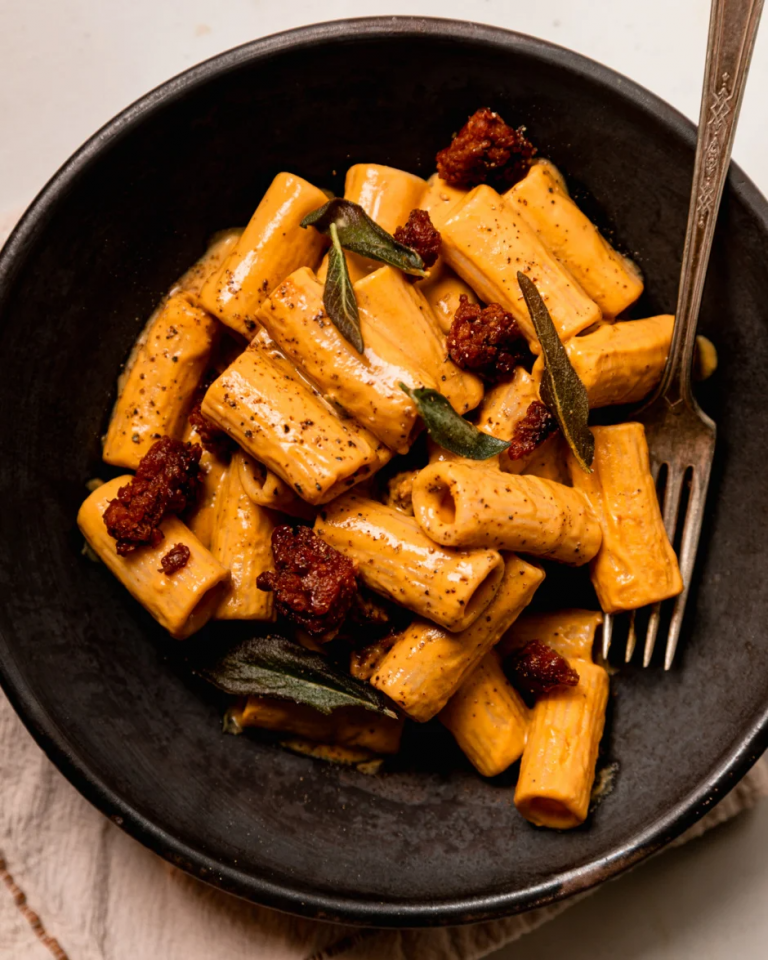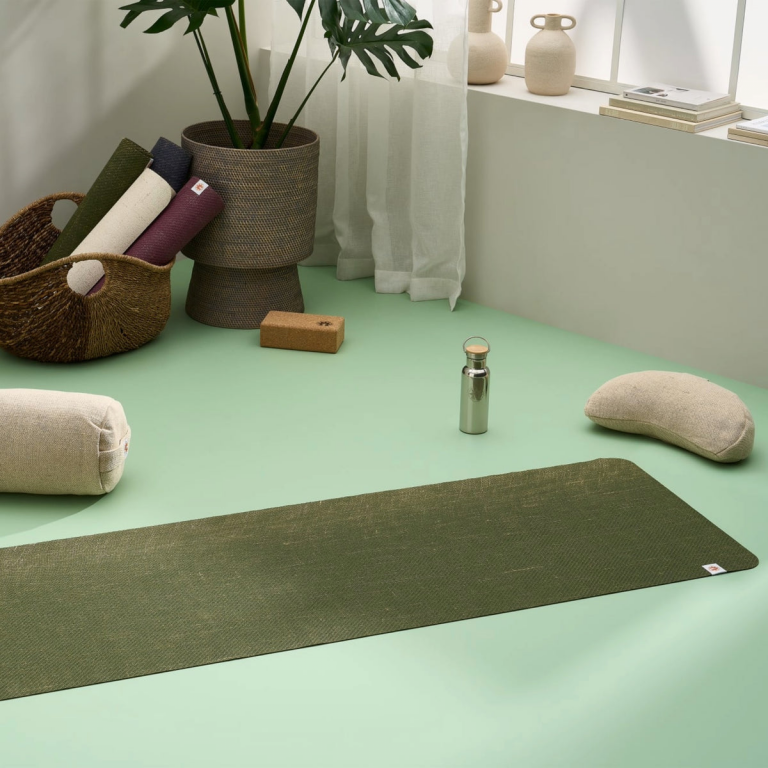
The Victoria sponge cake is a beloved classic across the UK, known for its light texture and simple, satisfying flavour. Traditionally, it’s a treat made with eggs and butter, often enjoyed with a cup of tea in the afternoon.
Recently, vegan baking has gained a lot of attention as more people seek plant-based options without missing out on their favourite cakes. This post will guide you through how to make a vegan version of the Victoria sponge, using straightforward ingredient swaps that keep the cake moist and fluffy.
This recipe for vegan Victoria sponge cake (The Veg Space) is just one of a few plant-based alternatives to try. It’s super-simple to make and extras keep for a few days, in an airtight tin.
Choose palm-oil-free vegan butter (like Flora). Before baking, read up on food safety for people and pets.
You’ll learn about the benefits of choosing vegan baking, how to replace eggs and dairy, and finally, find a clear recipe to try at home. Whether you’re vegan, have dietary restrictions, or just curious, this guide makes it easy to enjoy a classic cake with a fresh twist.
Victoria Sponge was indeed named after Queen Victoria, who would serve it to guests at her summerhouse on the Isle of Wight.
However, ‘sponge cakes’ go back to the 19th century, when people would take ‘tea and cake’ in the drawing room (dinner was eaten after 8pm back in the day).

Victoria Sponge Cake (Cupful of Kale) is another decadent recipe, again layering up fluffy vanilla sponges with fresh strawberries, strawberry jam and whipped vegan buttercream.
Flora vegan butters are all free from palm oil, choose the block version for a better cake. Oat milk works best for a soft crumb (avoid sweetened plant milks which could overpower the flavour).
A splash of apple cider vinegar mixed with your plant milk will make your cake even fluffier (the acid reacts with baking powder, making bubbles for a lighter sponge).
How Traditional Ingredients Went Vegan!
The classic Victoria sponge usually consists of four main ingredients: eggs, butter, sugar, and flour. These work together to create the cake’s distinctive texture and flavour.
- Eggs: Eggs act as a binder and help trap air during mixing. This trapped air expands in the oven, making the cake rise and giving it that tender crumb.
- Butter: Butter adds moisture and richness. It also helps to create a soft, melt-in-the-mouth texture.
- Sugar: Besides sweetness, sugar tenderises the cake by weakening gluten strands, which results in a softer bite.
- Flour: Typically, self-raising flour is used to give the cake extra lift, but plain flour with a little baking powder works just as well.
The finishing touches often involve a layer of jam and whipped cream or buttercream sandwiched between two sponge layers. These add flavour and moisture, making the cake even more delightful.
Distinct Texture and Flavour
When you bite into a traditional Victoria sponge, you expect a cake that is light but not dry, soft but not crumbly. It’s a fine balance that comes from the eggs and butter working in harmony with the flour and sugar. The outside has a gentle golden crust, while the inside is fluffy and slightly springy. The flavour is subtle, mostly sweet with rich buttery notes that pair perfectly with a fruity jam.
Why Traditional Components Challenge Vegan Baking
Switching to vegan baking means leaving out eggs, butter, and dairy-based creams—key ingredients in a Victoria sponge. Each of these poses a unique challenge:
- Eggs: Without eggs, it’s tough to trap air naturally, making the cake less fluffy and spongy.
- Butter: Replacing butter means finding something that keeps the cake moist and tender without altering the flavour too much.
- Cream: Vegan substitutes must mimic the thickness and richness of cream to achieve the same indulgent filling.
These traditional components aren’t easy to swap one-for-one, which is why creating a vegan Victoria sponge requires thoughtful substitutions to maintain the cake’s classic qualities. Understanding how those original ingredients work helps to find the right alternatives, so you can enjoy a truly satisfying vegan version.
Key Ingredients for Vegan Victoria Sponge
Making a vegan Victoria sponge means swapping out a few traditional ingredients, but it doesn’t mean you have to lose the cake’s delicate texture or subtle flavour. The challenge lies in replicating the role of eggs, butter, and cream with plant-based options that keep the sponge light and moist and the filling creamy. Getting these swaps right will maintain the cake’s classic qualities, so you can enjoy this treat without compromise.
Egg Alternatives: Binding and Leavening without Eggs
Eggs do important work in a Victoria sponge. They trap air to help the cake rise and provide structure by binding the ingredients together. Several plant-based options work well:
- Flaxseed or Chia “Eggs”: Mix 1 tablespoon of ground flaxseed or chia seeds with 3 tablespoons of water and let it sit until thickened. This creates a gel that binds ingredients effectively. It also adds a slight nuttiness that complements the cake’s flavour. The texture remains soft, though the crumb might be a little more tender.
- Aquafaba: The liquid from a can of chickpeas whipped until fluffy works like egg whites. It traps air for a light rise and adds moisture. Use 3 tablespoons of aquafaba to replace one egg. It won’t affect flavour, keeping the cake neutral.
- Mashed Banana or Applesauce: Both add moisture and mild sweetness while providing binding. Use about ¼ cup in place of one egg. These substitutes may add a slight fruitiness, so they suit cakes with jam fillings or fruity notes.
- Baking Powder and Vinegar: A combination of 1 teaspoon vinegar (apple cider or white) and 1 teaspoon baking soda can create enough lift in the cake when mixed promptly. It doesn’t bind as well alone but works alongside other substitutes.
If you want a sponge that’s light, fluffy, and holds its shape, flax eggs and aquafaba tend to be the most reliable.
Vegan Butter and Fats: Moisture and Richness without Dairy
Butter provides richness and moisture, which are essential for a soft sponge. The goal is to find plant-based fats that melt smoothly and don’t overpower the cake.
- Vegan Butter or Margarine: Many brands offer butter substitutes made from coconut oil, sunflower oil, or blends that mimic dairy butter’s texture. Use these as a direct swap. They give a similar mouthfeel and help trap air during creaming, which keeps the sponge light.
- Coconut Oil: Solid at room temperature, coconut oil can replace butter, though it has a distinct flavour that some people enjoy in cakes. It creates a tender crumb but may slightly change the taste and scent.
- Vegetable Oil: While oils like sunflower or light olive oil keep the cake moist, they don’t add the richness or creaming ability of butter. Use carefully with other binding agents to retain structure.
For the most familiar flavour and texture, vegan butter or margarine is the safest bet, especially those with a creamy consistency.
Cream and Fillings: Plant-Based Versions for That Classic Touch
A Victoria sponge isn’t complete without a creamy filling. The traditional whipped cream or buttercream develops richness and pairs beautifully with jam. Fortunately, vegan alternatives can do the same job well.
- Coconut Cream: The thick cream skimmed from chilled full-fat coconut milk whips up like dairy cream. It has a subtle coconut flavour that adds a tropical hint but blends well if you add a little vanilla extract.
- Soy or Oat-based Whipping Cream: Many plant-based creams made from soy or oats whip easily and have a neutral taste. They are ideal for replicating the lightness and stability of dairy cream.
- Vegan Buttercream: Made from vegan butter and icing sugar, this offers a richer, more stable filling that holds up well in warm weather. You can flavour this with vanilla or lemon for extra interest.
Sweeteners Suitable for Vegan Baking
Sugar is straightforward in vegan baking once you know what to look for. Some sugars are refined using bone char, so here are common vegan-friendly sweeteners:
- Organic Cane Sugar: Usually not processed with bone char and safe for vegans.
- Maple Syrup and Agave Nectar: These give a natural sweetness and can add moisture when used carefully.
- Brown Sugar: Look for brands that specify vegan production or opt for unrefined versions like muscovado.
Sourcing Quality Vegan Ingredients
To keep your vegan Victoria sponge tasting great, choose the best ingredients you can find:
- Look for vegan-certified butter or margarine with simple ingredients, avoiding those with hydrogenated fats.
- Buy organic or fair-trade sugar to ensure ethical production.
- Pick fresh or high-quality ground flaxseed or chia seeds for consistent egg substitutes.
- When using coconut cream, check the label to avoid added stabilisers or thickeners that might affect texture.
Using proper quality ingredients helps your cake rise well, stay moist, and deliver clean, fresh flavours that honour the traditional Victoria sponge spirit.
Preparing Your Ingredients and Equipment
Before you start mixing, make sure you have everything ready. Baking is all about timing and precision, so setting yourself up properly makes all the difference.
- Gather ingredients: vegan butter or margarine, caster sugar, plain flour, baking powder, vegan egg substitute (like flax egg or aquafaba), plant-based milk, vanilla extract, vegan jam, and plant-based cream or buttercream for filling.
- Measure carefully: use a kitchen scale for accuracy and a set of measuring spoons.
- Preheat your oven to 180°C (160°C fan) or Gas Mark 4.
- Prepare your cake tins: Line two 18cm round tins with parchment paper and lightly grease the sides with vegan butter or oil.
Having these ready helps everything run smoothly and avoids overmixing the batter.
Mixing the Batter
The key to a soft sponge is folding and creaming the ingredients carefully.
- Cream the vegan butter and sugar together in a large mixing bowl until the mixture looks light and fluffy. This traps air, which helps the sponge rise.
- Add the egg substitute: If using flax eggs, add them once the butter and sugar are creamed. If using aquafaba, whip it separately to soft peaks and fold it in gently.
- Pour in the vanilla extract for flavour.
- Sift the flour and baking powder together to avoid lumps.
- Add the dry ingredients alternately with the plant-based milk, folding gently. Start and finish with the flour. Mix until just combined; avoid overmixing or you risk a dense sponge.
This method keeps the batter airy and ready to rise beautifully in the oven.
Baking the Cake
After mixing, it’s time to bake your sponges.
- Divide the batter evenly between the two tins. Use a spoon or spatula to smooth the tops.
- Place both tins in the centre of the oven and bake for 20 to 25 minutes. Check after 20 minutes by inserting a toothpick in the centre; if it comes out clean, the cake is ready.
- Let the cakes cool in their tins for 10 minutes, then turn them out onto a wire rack to cool completely.
Avoid opening the oven door during baking, as this can cause the sponges to sink.
Preparing the Filling and Assembling the Cake
The filling is where you add the classic jam and cream combination that makes a Victoria sponge so special.
- Whip your plant-based cream or prepare vegan buttercream until fluffy and thick.
- Spread a generous layer of vegan jam on one of the sponge layers. Raspberry or strawberry work best.
- Top the jam with the cream or buttercream, spreading evenly.
- Place the second sponge on top, pressing down gently but firmly.
This creates a sturdy cake with plenty of flavour in every bite.
Decoration and Serving Tips
To keep the traditional look, simple decoration works best.
- Dust the top of the cake lightly with icing sugar.
- Add fresh berries on top for a pop of colour and natural sweetness.
- Use a few mint leaves or edible flowers if you want a little extra flair.
Cut your cake using a sharp serrated knife for neat slices. Serve with a cup of tea and enjoy the familiar comfort of this vegan classic.
Troubleshooting Common Issues
- If the cake sinks at the bottom, the oven temperature is too low, or you’ve opened the door. Keep the oven closed, and bake at the correct temperature (180 degrees C)
- Sponge too dense (overmixing the batter or not enough raising agent). Mix gently, and ensure proper baking powder use.
- Dry cake (overbaking or too little fat or milk). Reduce baking time slightly, and use fresh vegan butter and milk)
- Cake sticks to the tin (insufficient greasing or parchment). Grease tins well and use parchment paper properly.
Health Advantages of Vegan Cakes
Vegan cakes typically use wholefood ingredients such as plant oils, nuts, fruits, and whole grains. These ingredients can offer better nutrition compared to conventional cakes made with butter, eggs, and cream. Here’s why vegan cakes can be a healthier treat:
- Lower cholesterol and saturated fats: Without butter and eggs, vegan cakes usually have less cholesterol and saturated fat, which can help reduce the risk of heart disease.
- More fibre and nutrients: Using whole flours, nuts, and plant-based milks boosts fibre, vitamins, and minerals, helping digestion and overall health.
- Fewer additives and preservatives: Vegan baking often focuses on simple, natural ingredients that don’t carry additives sometimes found in processed dairy or eggs.
- Suitable for allergen-sensitive diets: Avoiding animal products makes these cakes safer for people with dairy or egg allergies or intolerances.
Registered nutritionist, Dr Sarah Thomas, highlights that “plant-based cakes tend to be gentler on the digestive system, with less risk of inflammation from animal fats. Choosing them occasionally supports a balanced diet without missing out on baked treats.”
Environmental Impact of Plant-Based Baking
Baking vegan cakes reduces your environmental footprint in clear ways. Traditional cakes rely heavily on animal agriculture, which contributes more greenhouse gases and uses much more water and land than plant-based foods. Here are the key environmental benefits:
- Lower carbon emissions: Producing plant-based ingredients generally releases fewer greenhouse gases than dairy farming or egg production.
- Reduced water use: Crops usually need far less water than animals, so vegan cakes help conserve precious water resources.
- Less land needed: Growing plants for food takes much less land than raising animals, meaning less deforestation and habitat loss.
- Smaller waste footprint: Plant ingredients typically generate less waste during production and processing.
Environmental scientist Laura Green notes, “Switching to plant-based baking shifts demand away from resource-heavy animal farming. It’s a simple change with a meaningful effect on your carbon footprint.”
Ethical Reasons for Choosing Vegan Desserts
Beyond health and environment, many people choose vegan cakes out of concern for animal welfare. Avoiding eggs, butter, and cream means no animals are harmed or exploited in the making of the cake. Factory farming practices often involve poor conditions for hens and dairy cows, issues that vegan options avoid.
- Animal welfare: Vegan cakes ensure no hens are kept in cramped cages and no cows are subjected to continuous milking cycles.
- Support for cruelty-free food: Choosing vegan desserts sends a strong message supporting kinder food systems.
- Promotes thoughtful consumption: It encourages awareness about where ingredients come from and promotes compassion.
Ethicist Dr James Carter explains, “Food choices reflect our values. Vegan baking offers a way to enjoy pleasure while respecting the lives of animals.”
Conclusion
A slice of vegan Victoria sponge cake brings all the charm of the traditional treat with added benefits. It’s light, moist, and delicious, made with plant-based ingredients that support health, the environment, and animal welfare. This cake fits perfectly with casual afternoon teas, birthdays, or any celebration where you want to offer a thoughtful and tasty option.
Baking it yourself is both satisfying and approachable, and sharing it with friends or family can make any occasion feel special. Choosing vegan baking means enjoying great flavour while inviting everyone to the table, no matter their diet.
Celebrate simple, inclusive baking that tastes great and makes a positive difference, one slice at a time.






